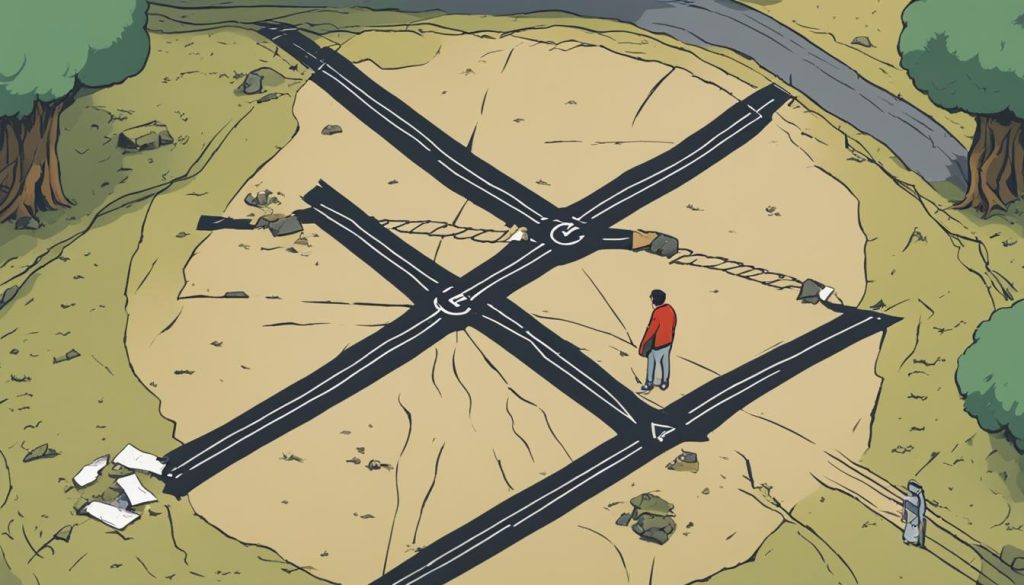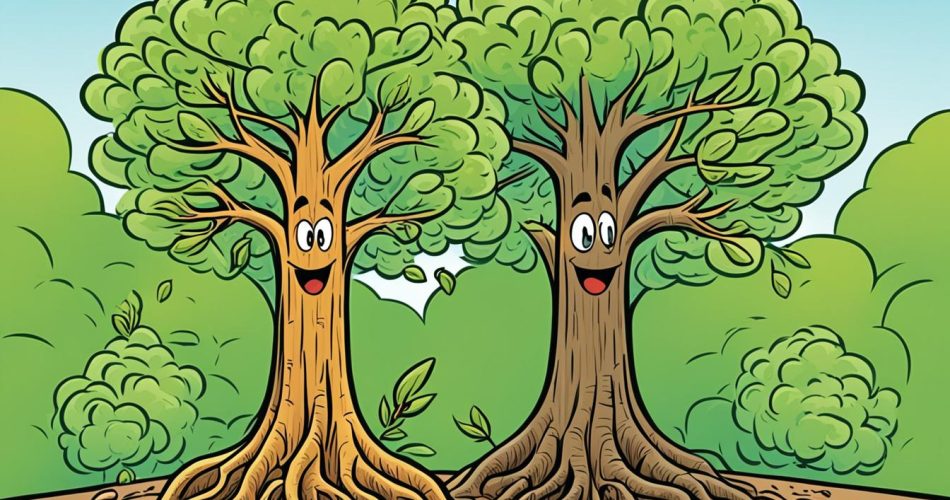Conflict is an inevitable part of any workplace. Rather than shying away from it, organizations should embrace conflict, using it as a catalyst for growth and innovation. In this article, I will explore the concept of productive conflict and how it can transform disputes into opportunities for positive change. By understanding the importance of conflict resolution, identifying the types of conflict, and leveraging productive conflict as a leadership tool, organizations can harness the power of disagreement to create a more productive and harmonious work environment.
Key Takeaways:
- Making conflict productive involves healthy confrontation and the open expression of different opinions.
- Productive conflict leads to increased productivity and the exchange of new ideas.
- Constructive conflict requires a healthy attitude and the development of conflict resolution skills.
- Productive conflict promotes team growth, encourages healthy debate, and fosters an environment of learning.
- It is vital to differentiate between constructive and destructive conflict and transform the latter into the former.
Why is Productive Conflict Essential to Team Growth?
Productive conflict plays a crucial role in the growth and development of a team. By encouraging healthy debate and challenging each other’s thinking, teams can foster an environment of learning and innovation. This section explores the significance of productive conflict in team growth, highlighting its impact on cognitive flexibility, productivity, and effective communication.
Healthy Debate and Challenging Perspectives
Productive conflict thrives on healthy debate, where team members are encouraged to express their opinions, share diverse perspectives, and challenge each other’s ideas. This exchange of contrasting viewpoints can lead to more robust decision-making processes and innovative solutions. When individuals engage in healthy disagreements, they are more likely to consider alternative approaches and find novel ways to overcome challenges.
An Environment of Learning and Growth
Productive conflict creates an environment of learning where team members can openly ask questions, share knowledge, and grow together. When individuals feel comfortable expressing their doubts and queries, they can benefit from the collective wisdom of the team and expand their own understanding. This collaborative learning not only enhances individual skills but also strengthens the team as a whole.
Working Toward Goals and Increased Productivity
Embracing productive conflict allows teams to work collaboratively toward their goals. By encouraging open discussion and debate, teams can identify potential roadblocks or weaknesses in their strategies and find ways to address them proactively. This iterative process leads to continuous improvement and increased productivity as teams streamline their workflows and refine their approaches.
Clarifying Doubts and Queries through Open Communication
Productive conflict enables team members to openly express their doubts and queries, leading to effective communication and problem-solving. When individuals feel empowered to seek clarification and ask questions, misunderstandings can be resolved promptly. This clarity fosters trust among team members and promotes a culture of open communication where concerns and challenges are addressed constructively.
Overall, productive conflict is an essential catalyst for team growth. By promoting healthy debate, creating an environment of learning, working toward common goals, and clarifying doubts and queries, teams can harness the power of productive conflict to unlock their full potential.
Identify the Type of Conflict: Constructive vs. Destructive

In any team or workplace, conflicts are an inevitable part of human interaction. However, not all conflicts are created equal. It is crucial to identify the type of conflict early on to address it effectively. Understanding the difference between constructive and destructive conflict can make all the difference in resolving conflicts and fostering a productive work environment.
Constructive Conflict
Constructive conflict is a type of conflict that focuses on finding a solution and leads to positive results that benefit all team members. It is characterized by open and healthy confrontation where individuals express their different opinions and perspectives in a respectful manner. This type of conflict promotes healthy debate, encourages the exchange of diverse ideas, and fosters collaboration among team members.
Destructive Conflict
In contrast, destructive conflict is unproductive and harmful to both individuals and the team as a whole. It hinders team growth, damages relationships, and creates a negative work environment. Destructive conflict is often characterized by personal attacks, hostile behavior, and a lack of respect for others’ opinions. It can escalate quickly, leading to a breakdown in communication and collaboration.
By recognizing the signs of destructive conflict and taking proactive steps to address it, teams can convert destructive conflicts into constructive ones. This resolution process involves creating a safe space for open communication, focusing on finding common ground, and working towards a mutually beneficial solution.
Here are some strategies to identify the type of conflict:
- Ask questions to assess the attitude of confrontation and determine if it is respectful and constructive or confrontational and destructive.
- Ensure everyone involved has the opportunity to speak and express their thoughts and opinions.
- Observe if emotions are escalating and contributing to a negative work environment.
With a clear understanding of the type of conflict at hand, teams and organizations can effectively manage conflicts and promote healthy confrontation. By transforming destructive conflicts into productive ones, teams can harness the power of constructive conflict and resolution to drive growth, collaboration, and innovation.
Productive Conflict as an Ally to Leadership

Effective leaders understand the power of productive conflict and its potential to transform negative situations into opportunities for growth and collaboration. By embracing conflict management strategies, leaders can empower their teams, promote open and honest discourse, and foster a culture of innovation and productivity.
One key aspect of effective leadership is the ability to transform negative conflict into productive conflict. Rather than viewing conflict as inherently destructive, skilled leaders recognize its potential as a catalyst for positive change. They understand that conflict, when managed effectively, can lead to increased understanding, better decision-making, and stronger relationships among team members.
“Conflict is an inevitable part of any team or organization. It’s how we choose to handle and harness that conflict that determines our success as leaders.” – John Maxwell
Productive conflict allows leaders to create an environment where teams feel empowered to express their opinions, challenge ideas, and engage in healthy debates. By promoting open and honest discourse, leaders encourage their teams to share diverse perspectives, which can lead to innovative solutions and more informed decision-making.
Furthermore, leaders play a crucial role in educating their teams about the value of conflict. By providing guidance on conflict resolution techniques and facilitating team discussions, leaders help their teams develop the skills necessary to navigate conflict in a constructive manner. This not only strengthens employee relations but also promotes a culture of continuous improvement and learning.
“As a leader, my goal is to empower my team to find their own productive conflict process. By equipping them with the right tools and providing a safe space for open communication, we can unleash their full potential and drive our organization forward.” – Sarah Rodriguez, CEO of XYZ Corporation
Leaders should actively encourage productive conflict rather than suppress it. Creating an environment where open communication and collaboration are valued allows teams to address conflicts head-on, leading to quicker resolutions and improved outcomes. By embracing productive conflict, leaders can foster an atmosphere of trust, transparency, and shared responsibility within their organizations.
Benefits of Productive Conflict for Leaders:
- Facilitates comprehensive problem-solving and decision-making.
- Encourages innovation and creativity through the exchange of diverse ideas.
- Strengthens employee relationships and fosters a sense of camaraderie.
- Builds trust and transparency among team members.
- Increases overall team performance and productivity.
Leaders who effectively manage productive conflict empower their teams to reach their full potential and drive the success of their organizations. By promoting open and honest discourse, embracing conflict, and providing the necessary support and guidance, leaders can create a culture that thrives on collaboration, growth, and continuous improvement.
3 Productive Conflict Examples
Productive conflict is a valuable tool in fostering a dynamic and innovative work environment. It allows teams to harness different perspectives and diverse skill sets to achieve better outcomes. Let’s explore three examples of productive conflict that can contribute to a more enriched work environment:
Creative Conflict:
During the brainstorming process, creative conflict occurs when team members generate divergent ideas and challenge existing assumptions. This type of conflict encourages conflicting ideas to collide and merge, leading to innovation and the development of novel solutions. By embracing creative conflict, teams can unlock their creative potential and arrive at groundbreaking solutions to complex problems.
Task Conflict:
Task conflict arises when team members coordinate tasks, assignments, and procedures. This type of conflict is rooted in differing opinions on how tasks should be executed or the allocation of responsibilities. Task conflict provides an opportunity for collaboration and clarification within the team. Through healthy disagreement and open discussion, task conflict helps optimize task completion and ensures effective utilization of team resources.
Relationship Conflict:
Relationship conflict emerges from clashes in personalities, values, or preferences among team members. It can stem from differences in communication styles, work habits, or personal preferences. While relationship conflict may initially seem unproductive, it can be beneficial for team growth. This type of conflict challenges individuals to embrace diversity, practice empathy, and foster inclusive work environments. By navigating relationship conflict with respect and understanding, teams can build stronger relationships and reap the benefits of diverse perspectives.
These examples illustrate the importance of productive conflict in driving innovation, collaboration, and personal growth within teams. By embracing healthy disagreement, diverse perspectives, and effective conflict resolution techniques, organizations can create a workplace culture that thrives on productive conflict and cultivates an environment of continuous improvement.
Conclusion
In conclusion, productive conflict plays a crucial role in transforming disputes and making conflict productive in organizations. It fosters healthy confrontation and encourages an exchange of diverse ideas, leading to increased productivity and innovative solutions. Instead of trying to remove conflict, organizations should focus on creating an environment of open communication and sharing, where constructive conflict is normalized.
Productive conflict is essential for team growth as it promotes healthy debate, learning, and collaboration. It empowers teams to work towards their goals, clarifying doubts and queries along the way. By embracing productive conflict, teams can achieve cognitive flexibility and improve overall productivity.
Being able to identify the type of conflict is crucial in maintaining a positive and productive work environment. Distinguishing between constructive and destructive conflict allows organizations to convert unproductive conflicts into productive ones, leading to positive outcomes. By assessing confrontation attitudes, providing equal opportunities for all to express their opinions, and managing escalating emotions effectively, teams can navigate conflict in a constructive manner.
Effective leaders understand the value of productive conflict and leverage it to their advantage. They transform negative conflict into productive conflict, fostering open and honest discourse within their teams. Through promoting productive conflict, leaders have the opportunity to strengthen relationships, enhance employee engagement, and create a collaborative work environment.
FAQ
What is productive conflict?
Productive conflict is a type of healthy confrontation where team members express their different opinions to reach a common solution.
How does productive conflict contribute to team growth?
Productive conflict increases productivity and encourages an exchange of new and different ideas, creating an environment of open communication and sharing in the workplace.
Should conflict be removed from the workplace?
No, trying to remove conflict in the workplace is impractical and hampers an organization’s growth. Normalizing productive conflict is important for creating an environment of open communication and sharing.
How can employees create constructive conflict?
Employees should approach conflict resolution with a healthy attitude and ensure teams have the right skills to work through differences, fostering healthy debate and challenging each other’s thinking.
What benefits does productive conflict bring to a team?
Productive conflict creates an environment of learning where team members can ask questions, share knowledge, and grow together, ultimately working towards their goals by promoting cognitive flexibility and increasing productivity.
How does productive conflict help in communication and problem-solving?
Productive conflict clarifies doubts and queries within a team, allowing for open communication and problem-solving, ultimately leading to positive results that benefit all team members.
What is the difference between productive conflict and destructive conflict?
Destructive conflict is unproductive, hinders team growth, and damages relationships. Productive conflict focuses on finding a solution and leads to positive results that benefit all team members.
How can leaders promote and transform conflict into a productive one?
Effective leaders embrace productive conflict and transform negative conflict into productive conflict by promoting open and honest discourse, educating their team on the value of conflict, and encouraging teams to find their own productive conflict process.
How does productive conflict benefit leadership?
Productive conflict allows leaders to grow healthy relationships within their organizations and strengthen employee relations by creating an environment of open communication and collaboration.
What are some examples of productive conflict?
Examples of productive conflict include creative conflict, which arises during the brainstorming process and encourages conflicting ideas to lead to innovation and novel solutions, as well as task conflict, which improves collaboration and clarifies job assignments and procedures. Relationship conflict, arising from clashes in personality or preferences, can also be beneficial for growth through diversity and inclusivity.

